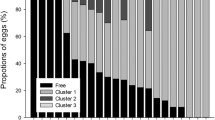Summary
Under laboratory conditionsMesostoma productum produces a batch of dormant eggs subsequent to a batch of subitaneous eggs. In nature only a few individuals change from dormant egg production to subitaneous egg formation in one batch of eggs.
The interval between hatching of the mother and hatching of her young from subitaneous eggs is 24.5 days at 15° C, 16.7 days at 20° C and 13.2 days at 25° C. These values are about 13,9 and 7 days lower than those forM. lingua.
The life-cycles extended over 3 months in 1968 and over 4 months in 1969 and 1970. The first generation hatching from dormant eggs only produces subitaneous eggs. All further generations hatch from subitaneous eggs. Under optimum conditions of 20° C the population produces subitaneous eggs. Average temperatures of 25° and 15° C cause dormant egg formation by a high percentage of the animals. Towards the end of the life-cycle the majority of eggs formed are dormant.
From the middle of May to mid-September 7 generations occur inM. productum, whereas inM. lingua the same number of generations occurs in 7.5–8 months.
Zusammenfassung
Im Laborversuch bildetMesostoma productum zunächst Subitaneier. In einer 2. Eigarnitur werden von denselben Individuen Dauereier produziert. Im natürlichen Lebensraum können sich nur wenige tiere während der Bildung einer Eigarnitur von Dauerei- auf Subitaneiproduktion umstellen.
Die Entwicklungsdauer vom Schlüpfen des Muttertieres bis zum schlüpfen der von ihr produzierten Jungtiere aus Subitaneiern beträgt bei +15° C 24,5 Tage, bei +20° C 16,7 Tage und bei +25° C 13,2 Tage. Diese Werte liegen um 13,9 und 7 Tage niedriger als beiM. lingua.
Die Lebenszyklen im untersuchten Tümpel erstrecken sich 1968 über 3 Monate, 1969 und 1970 jeweils über 4 Monate. Die erste Generation, die aus Dauereiern schlüpft, produziert ausschließlich Subitaneier. Alle folgenden Generationen stammen von Tieren aus Subitaneiern. Diese Tiere können sowohl Subitaneier als auch Dauereier bilden. Die Population produziert bei optimalen Durchschnittstemperaturen von +20° C Subitaneier. Durchschnittstemperaturen von +15° C oder +25° C führen bei einem hohen Prozentsatz der Tiere zu Dauerei-Bildung. Gegen Ende des Zyklus werden überwiegend Dauereier produziert.
Von Mitte Mai bis Mitte September bringtM. productum 7 Generationen hervor. Die gleiche Anzahl von Generationen erreichtM. lingua in 7,5–8 Monaten.
Similar content being viewed by others
Literatur
Gelei, J. v.: Plankton- und Warmwasser-Turbellarien in den ungarländischen Gewässern. Zugleich ein Beitrag zur Morphologie vonMesostoma productum. Zool. Jb., Abt. System., Ökol. u. Geogr.64, 111–128 (1933).
Heitkamp, U.: Die Mechanismen der Subitan- und Dauereibildung beiMesostoma lingua (Abildgaard, 1798) (Turbellaria, Neorhabdocoela). Z. Morph. Tiere71, 203–289 (1972).
Luther, A.: Die Eumesostominen. Z. wiss. Zool.77, 1–259 (1904).
Luther, A.: Die Turbellarien Ostfennoskandiens. IV. Neorhabdocoela 2. Fauna Fennica16, 1–163 (1963).
Mack-Fira, V.: Turbellariate din Romania (Archoophora, Prolecithophora, Proseriata, Rhabdocoela, Lecithoepitheliata). Univ. din Bucuresti, Fac. Biol., Dissertation 1970.
Rixen, J. U.: Kleinturbellarien aus dem Litoral der Binnengewässer Schleswig Holsteins. Arch. Hydrobiol.57, 464–538 (1961).
Steinmann, P., Bresslau, E.: Die Strudelwürmer (Turbellaria). Monographien einheimischer Tiere, Bd. 5, 380 S. Leipzig: Klinkhardt 1913.
Author information
Authors and Affiliations
Rights and permissions
About this article
Cite this article
Heitkamp, U. Entwicklungsdauer und Lebenszyklen vonMesostoma productum (O. Schmidt, 1848) (Turbellaria, Neorhabdocoela). Oecologia 10, 59–68 (1972). https://doi.org/10.1007/BF00822761
Received:
Issue Date:
DOI: https://doi.org/10.1007/BF00822761




